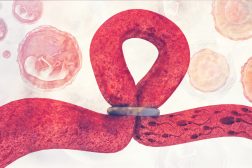Table of Contents
Definition
noun
plural: cytidine triphosphates
(biochemistry) An organic compound that is composed of cytidine (a cytosine ring and a ribose sugar) and three phosphate groups, hence, the name; a nucleotide with a chemical formula of C9H16N3O14P3
Details
Overview
A nucleotide is an organic compound made up of three subunits: a nucleobase, a five-carbon sugar, and a phosphate group. The sugar component may either be ribose or deoxyribose. A nucleotide is, thus, a nucleoside with a phosphate group. Depending on the number of phosphate groups attached to the sugar moiety, a nucleotide may be called nucleoside monophosphate (if with only one phosphate group), nucleoside diphosphate (with two phosphate groups), or nucleoside triphosphate (when with three phosphate groups).
Depending on the pentose sugar component, a nucleoside may be a ribonucleoside or a deoxyribonucleoside. A ribonucleoside is a nucleoside with a ribose sugar component. Based on the nucleobase component, the ribonucleoside may be adenosine, guanosine, cytidine, uridine, or 5-methyluridine. A deoxyribonucleoside is a nucleoside with a deoxyribose sugar. Similarly, depending on the nucleobase component, a deoxyribonucleoside may be deoxyadenosine, deoxyguanosine, deoxycytidine, thymidine, or deoxyuridine. Also, depending on the nucleobase component, the nucleosides may be grouped into either the “double-ringed” purine or the “single-ringed” pyrimidine.
Structure
Cytidine triphosphate (CTP) (chemical formula: C9H16N3O14P3) is a nucleoside phosphate comprised of a ribonucleoside and three phosphate groups. It means it has a ribose as its sugar and three phosphate groups attached. Its structure is comprised of a pyrimidine nucleobase, particularly cytosine, that is bound to the ribose sugar and three phosphate groups (attached to the 5′ carbon of the ribose). The removal of one or two phosphate groups yields cytidine monophosphate or cytidine diphosphate, respectively.
Common biological reactions
Common biological reactions
CTP may be biosynthesized de novo via the pyrimidine biosynthesis pathway. Cytosine, similar to other pyrimidines, is formed from a series of steps. First, carbamoyl phosphate is formed via carbamoyl phosphate synthetase. This is followed by the conversion of carbamoyl phosphate into carbamoyl aspartate by replacing the phosphate group with aspartate by the enzyme aspartate transcarbamylase. Carbamoyl aspartate is converted into dihydroorotate by dihydroorotase enzyme. Dihydroorotate next enters the mitochondria to be oxidized (by removal of hydrogens) by the help of the enzyme dihydroorotate dehydrogenase. This produces orotate. 5-phospho-α-D-ribosyl 1-pyrophosphate (PRPP), a ribose phosphate, reacts to orotate by donating a ribose group to the orotate, thereby forming orotidine-5-monophosphate (OMP). The enzyme that acts in this step is the orotate phosphoribosyltransferase.
OMP is then converted into other pyrimidines. The enzyme OMP decarboxylase facilitates the decarboxylation of OMP to yield uridine monophosphate (UMP). Phosphorylation of UMP leads to the formation of uridine diphosphate (UDP) (by the enzyme uridine-cytidine kinase 2) and uridine triphosphate (UTP) (by the enzyme nucleoside diphosphate kinase). Amination of UTP leads to the formation of cytidine triphosphate (CTP) by the action of the enzyme CTP synthetase.1
Breaking down of CTP (by losing two phosphates through the action of RNAse) leads to the formation of CMP. The catabolism of CMP into cytosine ultimately leads to the formation of the by-products β-alanine, NH3 and CO2. The general degradation pathway is as follows: cytosine » uracil » N-carbamoyl- β-alanine » β-alanine, CO2, and ammonia. Nonetheless, cytosine may be recycled via the salvage pathway. For instance, cytosine may be converted into uracil by deamination. By uridine phosphorylase, uracil is converted into uridine by reacting with ribose-1-phosphate. Through the enzyme nucleoside kinase, uridine is converted into UMP.
Biological functions
CTP contains chemical energy stored in its high-energy phosphate bonds. It releases energy when it is broken down (hydrolyzed) into CDP (guanosine diphosphate). The energy is used but limited to a small subset of metabolic reactions. CTP may also serve as a coenzyme in certain metabolic processes, such as glycosylation of proteins and the synthesis of glycerophospholipids.
CTP also serves as a direct component of RNA. Thus, it is an important substrate during the formation of mRNA, tRNA, and rRNA through the help of RNA polymerases.
Supplementary
Abbreviation(s)
- CTP
Chemical formula
IUPAC name
- (2R,3S,4R,5R)-5-(4-amino-2-oxopyrimidin-1-yl)-3,4-dihydroxyoxolan-2-ylmethyl(hydroxy-phosphonooxyphosphoryl)hydrogen phosphate
Synonyms
Further reading
See also
- nucleotide
- RNA
- cytosine
- cytidine
- deoxycytidine triphosphate (dCTP)
- cytidine monophosphate (CMP)
- cytidine diphosphate (CDP)
Reference
- Charma, K. & Somani, D. (2015). Pyrimidine Biosynthesis. Retrieved from Slideshare.net website: ://www.slideshare.net/kskuldeep1995/pyrimidine-biosynthesis-46874172 Link
© Biology Online. Content provided and moderated by Biology Online Editors







